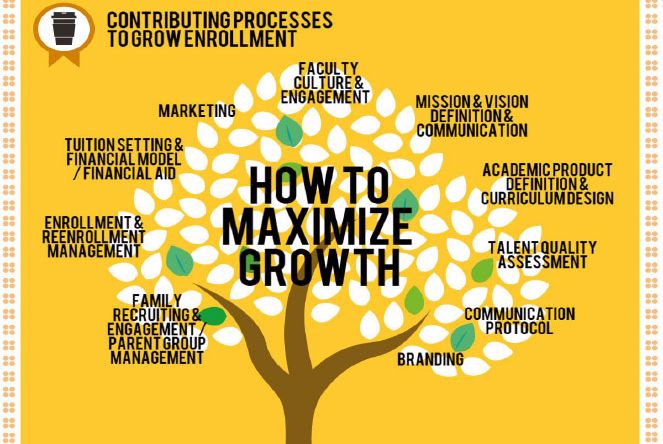Article by Tammy Barron and Scott Barron, School Growth
Have you noticed that some faculty and staff members seem to work energetically for your school’s mission, while others seem to come primarily for the paycheck? The difference between these groups can make a huge impact on the trajectory of your students and the financial sustainability of your school.
The difference is engagement, a topic of growing importance to many organizations and a critical factor in organizational success, according to reputable sources. Consider:
- Less than one-third of American employees are engaged — that is, involved in, enthusiastic about and committed to their work and Worldwide, that number is only 13 percent (source: Gallup).
- Teacher engagement is the most important contributing factor to student growth, yet 7 in10 teachers are found to be “less than engaged” in the mission and culture of their schools (source: Gallup).
- On average, schools invest less than 0.4 percent of their budgets in employee recruiting, and administrators spend less than 5 percent of their workweek mentoring and coaching faculty (source: SchoolGrowth research).
- A teacher’s talent, energy and engagement directly impact the life trajectory of his or her students. Administrators generally underestimate the critical importance of retaining great teachers and removing those who are not (source: TNTP).
- One factor uniting the most successful schools is active participation by faculty and parents in the enrollment process. That’s why growing numbers of schools are paying much closer attention to how they equip, mobilize and motivate these groups. The business office can play an important role in maximizing this engagement.
Developing engagement isn’t just another task to add to your job description. It’s really about the attitude and approach you take toward what you are already doing. The most effective business officers adopt the mindset that relationship-building is a primary part of their job. Let’s consider the challenges and opportunities of engaging faculty and families.
Faculty Are the Experience
When families choose a school, what are they really buying? At the heart of it, they want faculty who create a great experience for their children. Families may be attracted to the school because of the administrators they meet, the school’s mission and vision, and/or the admissions staff and tour. But they stay because of the experiences and relationships created each day by teachers, coaches and other staff members.
When school administrators invest the time to train and mentor all faculty and staff regarding their big-picture impact on the institution, they reap dividends including greater retention among current families and substantially higher admissions yields. Remind faculty and staff that, along with bringing high professional value to the school, they have the responsibility to deliver an exceptional experience to students and their families.
Consciously or not, many families compare their school experience against the full range of organizations with which they interact on a daily basis. This extends well beyond other schools. They’re actually “benchmarking” your service against the services provided by companies like Starbucks, Disney, Nordstrom, Amazon, Marriott and Apple.
Your leadership team should consider these key questions: How well does your school stack up against that broader competition within the family ecosystem? What adjustments can you make over the next 90 days to improve the level of service provided?
Delivering the Mission
People are schools’ greatest assets. Not only does your human capital investment likely represent more than 70 percent of your school’s operating budget, but the quality of the relationships and programs your people provide directly impacts the institution’s ability to achieve its mission and remain financially viable.
Claiborne Christian School in West Monroe, Louisiana, demonstrates the return on investment that can be achieved through paying attention to talent quality and engagement. In 2013, the school’s administration began measuring the “talent quotient” of its campus (at School Growth, we define TQ as the ratio of high-performing faculty to non-high-performing faculty). The leadership team then progressively raised the school’s TQ by removing a few underperforming people and adding a few others that were a better fit with the collaboratively developed talent rubric. The school also improved its hiring and coaching processes, organizational structure and faculty culture.
Through this disciplined approach over the last three years, Claiborne’s enrollment has grown 65 percent, its teacher retention has achieved the school’s goal level, and it has raised significantly more money.
A school’s business office can directly contribute to its talent quotient by continuously improving recruiting processes and practices and investing in professional development, evaluation and coaching, and communications. Reenrollment starts the first day of school and is the primary measurement of faculty effectiveness and accountability. Faculty must understand and prioritize their responsibility to deliver on the mission every day.
Communicating with Parents
Parent engagement also contributes to your school’s success. Retention of families and donor generosity peaks when you intentionally foster at least three deep relationships with each family, according to the “clients for life” methodology of John Gamble and Steve Wurzbacher. Having multiple connections creates stronger roots that are more difficult to sever, even when there is a disagreement or conflict.
Remember that word-of-mouth marketing is your best lead-generation tool. Most families who visit your campus for the first time heard about the school from a friend, family member or someone else in the community. Energize this tool by making families feel valued and appreciated as part of the “family.” Help them develop a sense of pride and confidence in the leadership and decision-making. Strive to “mobilize your masses” so that everyone contributes to recruiting families and donors, generating momentum as they do.
How the school communicates directly impacts these valuable connections.Do you have a communications protocol and plan that maximizes trust and confidence? Do you intentionally design and implement the sequence, frequency and flow of your messages? Do you maintain early and frequent communication, and do you proactively and responsively address concerns?
This mindset can be tremendously helpful in working with difficult parents or situations. Focus on customer service even at stress points. By maintaining a high degree of respect and humility, you will strengthen your emotional intelligence and keep families constructively engaged.
Collaborative Leadership: the Business Office’s Contribution
It’s very difficult to grow a school whose board and administration are still applying management techniques that assume a stable economic and societal environment.
Enrollment is a measure of school health and is affected by many internal and external factors. Collaboration between the business office and admissions office is vital to diagnosing problems, identifying issues and working together to learn, improve and ultimately resolve problems.
It’s very difficult to grow a school whose board and administration are still applying management techniques that assume a stable economic and societal environment. Moreover, board leaders and administrators sometimes attribute enrollment challenges to poor performance in the admissions office or inadequate investments in marketing. We believe that school design is more complicated and requires a different approach. We live in an innovation economy that is rapidly producing new competitors and new opportunities to serve.
Start by encouraging other administrators to clearly define expectations for maximum clarity and minimal frustrations. Teachers are more likely to be energized and engaged when they understand explicitly defined targets and outcomes. They also respond well to a culture of professionalism, and when they can see how classroom-related initiatives align with the larger priorities.
Two processes that significantly affect engagement are financial aid and tuition strategy. Collaboration with the enrollment office can produce more accurate data about and knowledge of the market forces that should influence these critical decisions. Both departments have important information about families who are slow to pay or are going through certain difficulties.
Seek creative solutions that provide appropriate accountability. When families are slow to pay, seek first to understand, with a little less black-and-white rule enforcement. Be open to the gray that respects people and the realities of life. As much as possible, provide a path for families to get out of financial difficulties, and move forward in your relationships with them so as to not see them through the lens of those past issues.
Create intelligence and stories out of combined financial and enrollment data to form a more complete picture of the strengths and opportunities of each program and division. Help other administrators and the board make better decisions: Analyze attrition rates at each grade level coupled with data from the enrollment funnel to more accurately assess performance and predict future results. This will also help determine how to strategically use financial aid and absorb changes in tuition income.
Collect survey data each fall from certain groups of families. Design questions carefully, and if possible ask them through personal interaction rather than digital forms. Find out why existing families don’t reenroll, why new families do enroll and why some choose not to enroll after going through the application process.
Finally, remember that new families are the last customers to “buy” your product. Their understanding of your value proposition relative to other options can help you improve your competitive position and brand.



.png?sfvrsn=e0147111_1)

